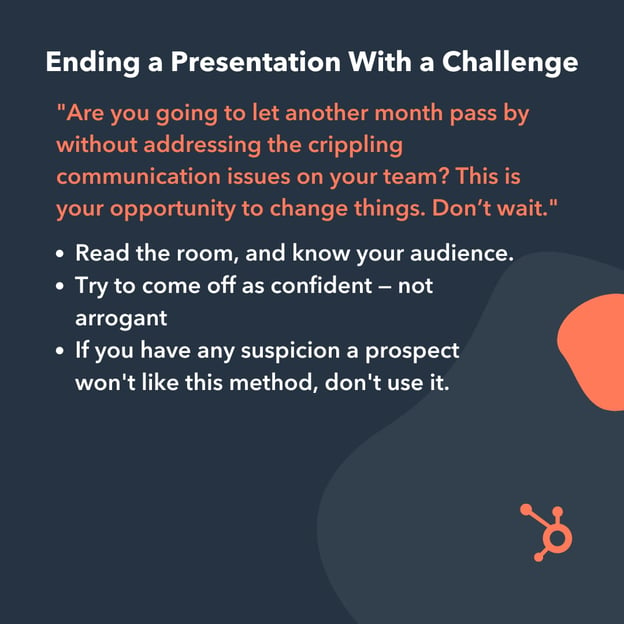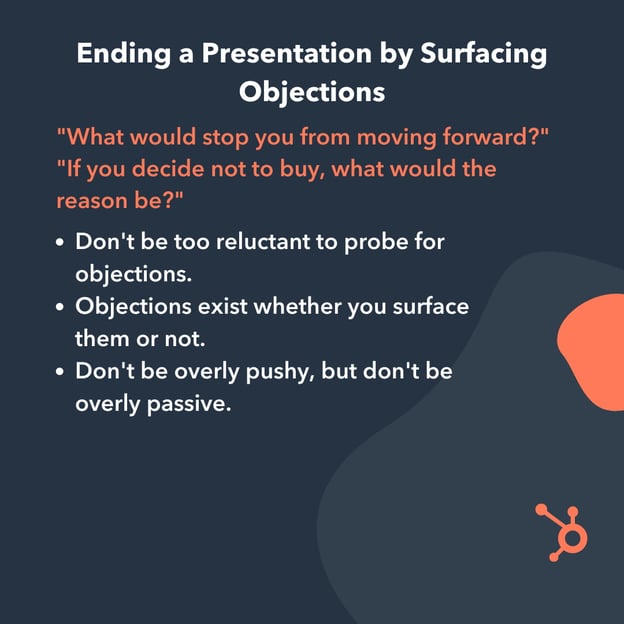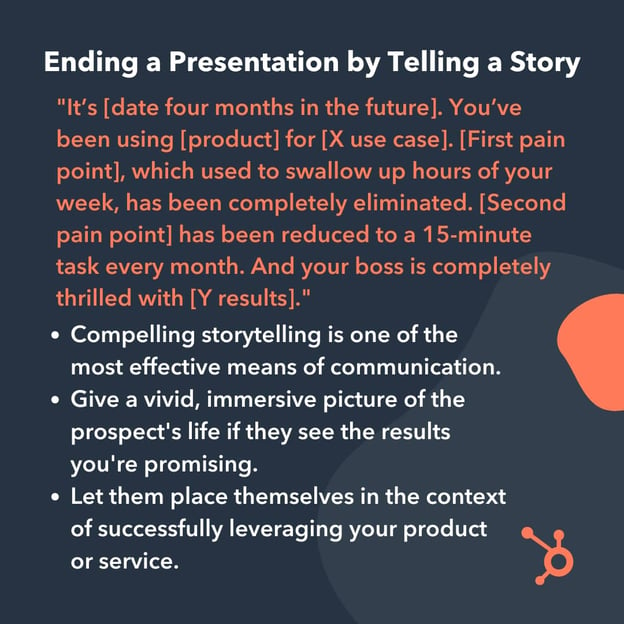A brilliant presentation is worth nothing if you don't bring it home with a powerful close — that said, many salespeople still struggle with how to end a presentation. Most sales presentations end with a whimper rather than a bang, taking a major toll on prospect's interest and enthusiasm.
.jpg)
To help you add a little extra oomph to your presentations and consistently end pitches on a high note, we've put together some tips for closing sales presentations — complete with some helpful examples.
Closing a Sales Presentation
- Go back to your opening anecdote or idea.
- End with a challenge.
- Invite your audience on a metaphorical mission.
- Use repetition for a dramatic close.
- Offer inspiration.
- Surface their objections.
- Tell a story.
- Ask an unusual question.
- End with a quote.
1. Go back to your opening anecdote or idea.2. End with a challenge.3. Invite your audience on a metaphorical mission.4. Use repetition for a dramatic close.5. Offer inspiration.6. Surface their objections.7. Tell a story.8. Ask an unusual question.9. End with a quote.
1. Go back to your opening anecdote or idea.
Starting a presentation with an anecdote, analogy, case study, or thought-provoking idea can set things off with an intriguing tone — and referring back to that point at the end can add an element of compelling cohesion to your pitch.
For example, let's say you're presenting on behalf of a company selling a conversation intelligence platform to an enterprise-level prospect. You might start with something like:
"Client X's sales development team was qualified, competent, and motivated. SDRs were reliably connecting with prospects, but their conversion rate was hardly over half of what leadership wanted to see. That's where we came in."
Then, you would give your presentation — offering an overview of your product, value proposition, specs, and tailored solution. Once you've covered those bases, and it's time to wrap things up, you could say:
"Remember Client X? Well, after implementing our solution, they were able to refine their messaging, provide reps with better-informed coaching, and identify the most resonant pain points prospects were consistently raising. All told, they more than doubled their conversion rates on calls while maintaining their existing cadence."
That kind of "closed loop" synchronicity is clean and interesting — that's why bringing everything together with a self-referential nod to the beginning of your presentation is one of the better ways to cap things off.
2. End with a challenge.

Leaving your prospects with a dramatic, open-ended challenge is one of the most effective ways to keep yourself top-of-mind after your presentation ends and motivate a buyer to act.
For instance, you might say, "Are you going to let another month pass by without addressing the crippling communication issues on your team? This is your opportunity to change things. Don’t wait."
But be careful, you need to tread lightly if you decide to go this road. Read the room and exercise caution. There's always a thin line between confidence and arrogance, and if you cross it in front of the wrong person, you could be in trouble.
If you're too brash and challenge a prospect with an "alpha" personality, you might wind up rubbing them the wrong way and do more harm than good. If you have even the slightest suspicion that your buyer might not be receptive to this tactic, go with another one.
3. Invite your audience on a metaphorical mission.
This tactic is sort of a spin on the point above — one that's a bit more collaborative and less confrontational. Instead of challenging your prospect, ask them to join you on a mission or journey.
You might say something like:
"More than 5,000 companies have decided to leverage our solution and invest in their employees' health. Are you ready to join them?"
It's more inspirational than a direct challenge but a little less frank — sacrificing some directness in the interest of caution. Still, when done right, it can inspire action.
4. Use repetition for a dramatic close.
Research shows repetition improves a child’s ability to recall new terms — in other words, if they hear an unfamiliar phrase multiple times, they’re more likely to remember it than if they only heard it once.
But that trend isn't specific to kids — the same principle applies to adults. A repetitive rhythmic close is memorable, but its value doesn't stop there. It can also be high-energy and engaging.
Not sure what this would sound like? Take a look at this example:
"If you don’t have transparency, you don’t have trust. If you don’t have trust, you won’t get honest feedback. If you don’t get honest feedback, you’ll develop blind spots. If you develop blind spots, you’ll make poor decisions, lose talented employees, and miss crucial opportunities for improvement."
5. Offer inspiration.
A well-chosen quote can tie your entire sales pitch together and help put things in a new light for your prospect.
Let's say you're selling a new CRM to a midsize business. The buyer is interested, but they know implementing a new system could be a long, challenging process.
With that in mind, you might close with something like:
"Look, I know the thought of changing CRMs is probably scary. But I think one of my favorite Warren Buffett quotes applies nicely here: ‘Should you find yourself in a chronically leaking boat, energy devoted to changing vessels is likely to be more productive than energy devoted to patching leaks.’
In the long run, this switch will save your company a lot of time, money, and effort."
6. Surface their objections.

When you sense your prospect isn’t quite convinced — or they’re not being completely open about — you can try ending your presentation by digging for objections.
HubSpot sales reps use this question: "What would stop you from moving forward?"
You can also try, "If you decide not to buy, what would the reason be?"
The thought of being so direct can be nerve-racking, but you need to keep the fact that your prospect's objections exist — regardless of whether you probe for them. Those concerns are real and will likely come to light eventually, and you can't resolve them if you have no idea what they are.
7. Tell a story.

A story is one of the — if not the — most powerful communication vehicles salespeople have at their disposal. Telling a story makes your message more compelling, digestible, and emotionally resonant.
I recommend telling a hypothetical story of your prospect’s life after they’ve bought your product:
"It’s [date four months in the future]. You’ve been using [product] for [X use case]. [First pain point], which used to swallow up hours of your week, has been completely eliminated. [Second pain point] has been reduced to a 15-minute task every month. And your boss is completely thrilled with [Y results]."
By framing your presentation with immersive descriptions of the results your prospects can expect to see, you're helping them mentally place themselves as existing customers. If you can do that convincingly, this tactic can go a long way.
8. Ask an unusual question.
You don't have to cut your presentation short by asking, "Does anyone have questions?" Instead, try turning the tables by asking an anything-but-ordinary question at the end of your presentation.
This will jolt them back to the conversation at hand and give you a unique entry into the final portion of your presentation. Here are some example questions:
- "How did I change your worldview or perception?"
- "Based on what you've just heard, would you buy today? Why or why not?"
- "What's changed between now and when I began this presentation?"
The conversations prompted by these questions are sure to be more interesting than an ordinary close. And it might go without saying, but you still have to follow up by answering any questions they have.
9. End with a quote.
Whether it's a killer client quote or your favorite Dylan lyric, ending with a thought-provoking line will cause your audience to pause.
From there, take a few moments to ask how the quote resonated with your audience and what it made them consider. They might have offering-related thoughts — or share something completely unrelated to your business.
The point of this exercise is to snap them out of the end-of-presentation daze and get them excited and inspired to think bigger. Choose the right quote and spur your prospect to action at the end.
Here are a few other presentation ideas:
Sales Presentation Ideas
- Share a unique "vision statement " for your prospect - Wow your audience by sharing a personalized vision statement for how you see your offering changing their work and their business.
- Nix language-heavy slides for images - Go easy on the eyes and provide images narrated by your key points.
- Use movement and gestures - Avoid a rigid, unmoving stance. Use natural or slightly animated gestures to give your presentation life.
- Include video or animation - You never want to distract from your main points, but a well-placed video or custom animation can help rather than hindering your presentation.
- Don't shy away from emotion - When appropriate, share a joke, a personal anecdote, or passionate story.
- Always personalize your presentation - Keep things relevant for your audience by customizing every presentation you give.
- Tell stories using your data - You know what's less boring than a slide full of bullet-pointed numbers? You telling a story with your data.
- Ask questions throughout your presentation - Make things interactive by engaging regularly with your audience and asking for their thoughts and opinions.
- Make examples personal - Reminding your audience of your humanity is crucial for them to feel connected and sympathetic to you.
- Use music - "Music embedded throughout a PowerPoint presentation can sustain attention, while slipping content into long-term memory,"says Ronald A. Berk of The Johns Hopkins University
With these creative and effective ways to end and facilitate a sales presentation, your close rate is bound to improve.
Sales Presentation


